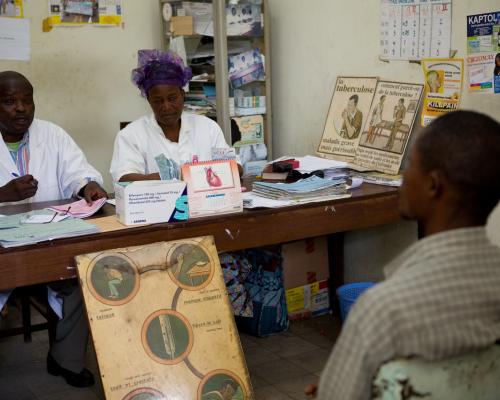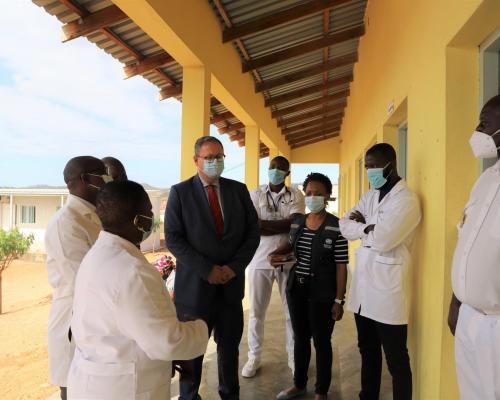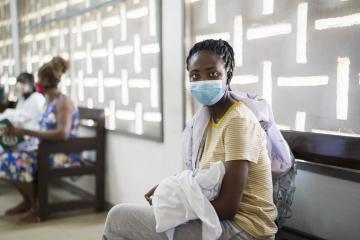-
Factsheet
-
Key Facts
- TB was the second leading infectious disease killer worldwide, after COVID-19. It was also the leading killer of people with HIV and a major cause of deaths related to antimicrobial resistance.
- In 2022, 2.5 million people fell ill with TB in the African region, accounting for a quarter of new TB cases worldwide.
- An estimated 424,000 people died from the disease in the African region (1.267 million globally) in 2022. Over 33% of TB deaths occur in the African Region.
- In 2022, Eight countries accounted for more than two-thirds of the global total: India, Indonesia, China, the Philippines, Pakistan, Nigeria, Bangladesh and the Democratic Republic of the Congo.
- In 2022, an estimated 1.3 million children became ill with TB and 250 000 children died of TB (including children with HIV-associated TB).
- TB is a leading killer of HIV-positive people: in 2022, 26% of HIV deaths were due to TB.
- Multidrug-resistant TB (MDR-TB) remains a public health crisis and a health security threat. WHO estimates in 2022 that there were 410 000 cases with resistance to rifampicin at the global level and 62 000 in the African region.
- Globally, TB incidence has fallen from 2015 to 2022 to -8.7% in the Africa region at the same period the reduction was 23%. This needs to be accelerated to reach the 2025 milestones of the End TB Strategy which is a 50 % reduction of incidence compared to 2015.
- Globally an estimated 44 million lives were saved between 2010 and 2022 and 10 million lives were saved in the African Region between 2010 and 2022 through TB diagnosis and treatment.
- Ending the TB epidemic by 2030 is among the health targets of the Sustainable Development Goals.
- Tuberculosis mostly affects adults in their most productive years. However, all age groups are at risk.
- People who are infected with HIV are 20 to 30 times more likely to develop active TB (see TB and HIV section below). The risk of active TB is also greater in persons suffering from other conditions that impair the immune system.
- 1.3 million children (0–14 years of age) fell ill with TB in 2022 and in Africa, 325 000 children developed TB
Tuberculosis (TB) is a serious infectious disease that affects people all over the world. While most cases (over 80%) occur in low- and middle-income countries, TB remains a threat everywhere.
According to the World Health Organization (WHO), the South-East Asian Region bore the highest burden of new tuberculosis (TB) cases in 2022, accounting for 46%. Africa followed closely at 23%, and the Western Pacific region reported 18% of new cases.
Individuals most at risk of developing TB are adults in their prime working years. However, people of all ages can be infected. Certain factors increase a person's vulnerability, including:
- Weakened immune system: This can be caused by HIV/AIDS, malnutrition, diabetes, or tobacco use.
- Undernutrition: In 2022 alone, an estimated 2.2 million new TB cases were linked to undernourishment.
The cost of TB can be devastating. Globally, half of TB patients and their families face financial catastrophe due to the disease, spending over 20% of their household income on medical bills, lost wages, and other expenses.
Combating TB requires a multi-pronged approach, focusing on both prevention and treatment efforts. This will help reduce the global burden of TB and protect individuals from its devastating consequences.
Common symptoms of TB disease include:
- Prolonged cough
- Chest pain
- Weakness or fatigue
- Weight loss
- Fever
- Night sweats
Often, these symptoms will be mild for many months, thus leading to delays in seeking care and increasing the risk of spreading the infection to others.
If the healthcare provider suspects a patient to have TB disease, they will send the patient for testing. In the case of suspected lung TB disease, patients will be asked to give a sputum sample for testing for TB bacteria. For non-lung TB disease, samples of affected body fluids and tissue can be tested. WHO recommends rapid molecular diagnostic tests as initial tests for people showing signs and symptoms of TB. Other diagnostic tools can include sputum smear microscopy and chest X-rays.
With TB infection, a person gets infected with TB bacteria that lie inactive in the body. This infection can develop into TB disease if the immune system weakens. People with TB infection do not show any signs or symptoms of TB. To identify TB infection, healthcare providers will screen at-risk patients to rule out active TB, and they may use a skin or blood test to check for TB infection.
TB disease is curable. It is treated by standard 6-month course of 4 antibiotics. Common drugs include rifampicin and isoniazid. In some cases, the TB bacteria does not respond to the standard drugs. In this case, the patient has drug-resistant TB. Treatment for drug-resistant TB is longer and more complex.
The course of TB drugs is provided to the patient with information, supervision and support by a health worker or trained volunteer. Without such support, treatment adherence can be difficult. If the treatment is not properly completed, the disease can become drug-resistant and can spread.
In the case of TB infection (where the patient is infected with TB bacteria but not ill), TB preventive treatment can be given to stop the onset of disease. This treatment uses the same drugs for a shorter time. Recent treatment options have shortened the duration to treatment to only 1 or 3 months, as compared to 6 months in the past.
In 2022, Africa was estimated to have 25.6 million people living with HIV (ranging from 21.6 million to 30.0 million), of whom approximately 1.8%, or an estimated 461,000 (ranging from 395,000 to 533,000) individuals, contracted TB for the first time (new incidence) in the same year.
People living with HIV are 20 to 30 times more likely to develop active TB disease than people without HIV. 58% of HIV-positive people (newly enrolled in care) are on preventive treatment against TB in the region in 2022.
WHO recommends a 12-component approach of collaborative TB-HIV activities, including actions for prevention and treatment of infection and disease, to reduce deaths.
Anti-TB medicines have been used for decades and strains that are resistant to 1 or more of the medicines have been documented in every country surveyed. Drug resistance emerges when anti-TB medicines are used inappropriately, through incorrect prescription by health care providers, poor quality drugs, and patients stopping treatment prematurely.
Multidrug-resistant tuberculosis (MDR-TB) is a form of TB caused by bacteria that do not respond to isoniazid and rifampicin, the 2 most powerful, first-line anti-TB drugs. MDR-TB is treatable and curable by using second-line drugs. However, second-line treatment options are limited and require extensive chemotherapy (up to 2 years of treatment) with medicines that are expensive and toxic.
In some cases, more severe drug resistance can develop. Extensively drug-resistant TB (XDR-TB) is a more serious form of MDR-TB caused by bacteria that do not respond to the most effective second-line anti-TB drugs, often leaving patients without any further treatment options.
The World Health Organization (WHO) estimates that 62,000 new cases of MDR-TB occurred in the African Region in 2022.
Among these new cases, 2.3% were resistant to rifampicin, the most effective first-line treatment, requiring MDR-TB specific therapy.
This proportion is significantly higher (12%) for patients undergoing retreatment for TB, highlighting the challenge of drug resistance.
In accordance with WHO guidelines, detection of MDR/RR-TB requires bacteriological confirmation of TB and testing for drug resistance using rapid molecular tests or culture methods.
In 2022, new WHO guidelines prioritize a 6-month regimen – the BPaLM/BPaL – as a treatment of choice for eligible patients. The shorter duration, lower pill burden and high efficacy of this novel regimen can help ease the burden on health systems and save precious resources to further expand the diagnostic and treatment coverage for all individuals in need. In the past, MDR-TB treatment used to last for at least 9 months and up to 20 months. WHO recommends expanded access to all-oral regimens.
WHO pursues 6 core functions in addressing TB:
- Providing global leadership on matters critical to TB.
- Developing evidence-based policies, strategies and standards for TB prevention, care and control, and monitoring their implementation.
- Providing technical support to Member States, catalyzing change, and building sustainable capacity.
- Monitoring the global TB situation, and measuring progress in TB care, control, and financing.
- Shaping the TB research agenda and stimulating the production, translation and dissemination of valuable knowledge.
- Facilitating and engaging in partnerships for TB action.
Growing political commitment in the African region is driving progress towards ending the TB epidemic. Many countries have endorsed the WHO End TB Strategy and its regional framework, both of which set ambitious but achievable targets for reducing TB by 2030.
These targets aim for:
- 90% reduction in TB deaths compared to 2015 levels.
- 80% reduction in new TB cases compared to 2015 levels.
- Elimination of catastrophic costs faced by TB-affected families.
The WHO End TB Strategy, adopted globally in 2014, provides a roadmap for achieving these goals. It sets similar global targets for TB reduction and emphasizes eliminating the financial burden of TB on families.
Looking beyond 2030, the WHO has even more ambitious targets to virtually eliminate TB as a public health threat by 2035.
The Strategy outlines three strategic pillars that need to be put in place to effectively end the epidemic:
- Pillar 1: integrated patient-centred care and prevention
- Pillar 2: bold policies and supportive systems
- Pillar 3: intensified research and innovation
The success of the Strategy will depend on countries respecting the following 4 key principles as they implement the interventions outlined in each pillar:
- government stewardship and accountability, with monitoring and evaluation
- strong coalition with civil society organizations and communities
- protection and promotion of human rights, ethics, and equity
- adaptation of the strategy and targets at the country level, with global collaboration



